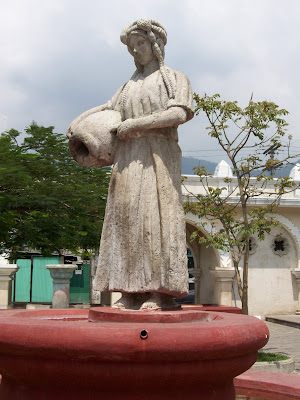As I sit in the colonial gem that is the city of Antigua Guatemala, enjoying the temperate weather and the marimba music drifting from the nearby central park, I will address a few questions that were submitted to me by AEACMS students. Since I literally received dozens, I have condensed these into categories. Today I will deal with the categories of
Transportation and
Housing.
Several students asked me to provide information on the various ways in which Guatemalans travel around this moderate-sized but geographically-challenging country. Others, prompted by an IB unit in Ms. Burnham's Spanish class, had questions about the various forms of dwellings in Guatemala.
TRANSPORTATION
One of the major challenges to transportation in Guatemala stems from the lack of a nation-wide system of high-quality and well-maintained roads. This is not such an issue near the capital Guatemala City (and where I presently am in Antigua), but in more rural areas the percentage of paved roads decreases significantly.
I arrived from the airport in a shuttle bus, yet a large percentage of Guatemalans travel by bus. There is an extensive system of buses, both within cities as well as in rural areas. You will note the photo of the bus in this posting; I visited the bus depot in Antigua today--a large, dusty lot bustling with the activity of passengers coming and going. My hotel sits a few blocks from the depot, and last night it seemed that buses operated without interruption. Most buses have
ayudantes or helpers who assist the drivers, recruit passengers, load luggage on roofracks, and collect fares. Their urgent hawking cries can be heard as they try to pack as many passengers on board as will physically fit. You will note the photo of the
ayudante on the roof--this bus was in motion, and it is not uncommon for these helpers to climb outside the bus and onto the roof while traveling at high speeds.
In addition to buses and cars, many Guatemalans travel by bicycle (short distances) and motorcycle. There does not appear to be a helmet law for motorcycles. Many deliveries are made by motorcycle.
I have also included some photos of people riding horses in Antigua; it appears that for the most part these are for tourists to hire, much as in New York's Central Park.
Whatever the mode of transportation, within Antigua the roads are made of cobblestones, which makes for slow progress. In rural areas, during the rainy season (May-October), dirt roads often turn to impassable mud troughs.
Coming from Southern California, where we live in our cars and take high-speed, hassle-free transportation for granted, being here forces me to consider the benefits of both contexts: getting where we need to go in a hurry has its merits, but so does slowing down and enjoying the view--and the bumps and potholes--along the way.
HOUSING
Once we start the service project in the Guatemala City dump tomorrow morning, I will be able to add more impressions to this category. However, I have included a variety of photos here that highlight some of the various features of dwellings in Antigua.
One of the most interesting observartions for me is that the houses are all connnected, forming a continuous wall to the street. Yards tend to be small, and mostly within the center of the house, surrounded by four protecting walls. I am posting this from a wonderful courtyard seating area, with a gurgling fountain at its center and small grass areas. Because the climate is mild--similar to San Diego--in many houses moving from room to room requires that you go outside into an open corridor.
Another striking element that can be seen in some of these pictures is the haphazard mix of colonial buildings--some of them ruined in the multiple earthquakes and floods that have decimated this city over the centuries--and modern architecture and building supplies. The aerial photos were taken from the roof of my hotel. They show that although some of the architecture here has endured centuries (note the width of the walls), other construction is much more temporary (note the lamina rooftops and cinderblock).
I hope that I have anwered some student questions, and generated others. I look forward to your comments on this blog, and will undoubtedly have more to say after the service project officially begins tomorrow. I am off to meet my fellow volunteers who have just arrived from various parts of the US.
Hasta pronto.
DS



